Returning a Treasure
I, by inheritance, own a small head—sandstone, I think—which my mother bought around 1936 from the National Museum in Phnom Penh, as far as I know. She documented this in a travel journal, which I’ve temporarily misplaced. It was sold as coming from Wat Ta Keo, which I gather is near Angkor Wat.
I was deeply touched by Tess Davis’ article (“Returning Duryodhana,” Summer 2014), and along with my rage at Sotheby’s, her disclosures brought me a welter of emotions. For instance, when my parents visited Angkor Wat and bought this statue, Head of a Dancer, it was in all innocence and naïveté. Nor was it a blood antiquity at the time.
Yet it was undoubtedly looted from Ta Keo, and as much as I love it, I most strongly wish to know how to contact the proper people and return it to Cambodia.
David Carroll (CAS’73)
Dexter, Mich.
Editor’s note: David Carroll and Tess Davis are working with the Cambodian government to return the statue.
Upbeat about Journalism
I really enjoyed the conversation on journalism, technology, and business models (“Journalism Is Still Serious, Just Different,” Summer 2014). David Carr, Andrew Lack, and Thomas Fiedler were refreshingly honest and upbeat, but not just for upbeat’s sake. They are right to point out the increasing emphasis on storytelling and the interest many successful investors are taking in news and information (John Henry buying the Boston Globe, for example). As a news reporter myself, I remind students and interns that while platforms are constantly changing, there’s always demand for high-quality content.
Anne Mostue (COM’06)
Boston, Mass.
Edward Snowden’s story came to light through Glenn Greenwald, a carefully selected journalist at the Guardian. In his interview, David Carr of the New York Times mentions it was laughable that the Guardian broke the story of the year. I found it incredibly arrogant (not the only bit of arrogance in Carr’s interview). Many of the more well-established publications have criticized Greenwald and the Guardian. But there is a reason that these “bastions of the free press” didn’t break the story. Very often they sanitize themselves of news regarding the NSA, CIA, and the DOJ. When [former US intelligence official] William Binney came out to discuss many of the same programs that Snowden did two years prior, it was barely recognized by the Times. Perhaps instead of focusing on the “new media,” Carr should focus on the intrepid journalism that we all crave.
Jeremy Krumsick (CAS’08)
Brooklyn, N.Y.
Protest, or Provoke?
I enjoyed reading Susan Seligson’s “Civil Disobedience, A Love Story” (Summer 2014).
I must take issue with several points concerning Seligson’s adulatory portrayal of Rabbi Susan Silverman’s activism on behalf of liberal Jewish beliefs in Jerusalem.
Israel is not America, Jerusalem is not Boston, and the Wailing Wall is not the Boston Common speakers podium. It is one thing to protest; it is another to provoke.
Rabbi Silverman is portrayed as being enlightened, progressive, and liberal. Fine. But perhaps self-righteous, condescending, and intolerant better describe her views. Rabbi Silverman came to Israel hoping to make a change. That’s her right. But others came hoping to continue and strengthen their attachment to a traditional view of Judaism that dates back well over 2,000 years. That is their right. Many fled from societies that were not tolerant enough to accommodate their beliefs. They came to Israel expecting to be free from religious intimidation and outright coercion.
One would hope that Rabbi Silverman is more understanding of Muslims’ right to pray as they wish than she is of her fellow Jews’ right to express their cherished beliefs in a manner that differs with hers.
In order to gain the respect of others, one must at times show them respect.
Stuart Katsoff (CAS’80)
Tel Aviv, Israel
Thank you for the update on Yosef Abramowitz and his wife, Susan Silverman. Yosef was quite the campus fixture during my time at BU. Even those, like me, who did not know him personally, knew well about his activism and his “celebrity.” To illustrate that point, on one occasion my then-girlfriend asked me to walk her home from the Castle to Myles even though I was already late for class. Looking down Bay State Road, I offered a compromise: “I’ll walk you to Yosef,” I suggested, spying Yosef coming toward us in front of Towers. She spotted him as well and simply said, “That’ll do.”
Daniel Warner (SED’87)
Sugar Land, Tex.
In Praise of a Fellow Alum
Great and eerily timely piece on filmmaker Chiemi Karasawa (COM’90) and her documentary about the legendary talent Elaine Stritch (“Alumni Notes,” Summer 2014).
As you know, Stritch died on July 17. Karasawa’s fine documentary is being talked about and referenced in numerous tributes as the definitive work on this truly one-of-a-kind personality.
Kudos to Karasawa on her fine work from a fellow COM alum.
Basil O. Gordon (COM’75)
Columbia, Md.
Belief in Immortality
I was glad to read about the cleverly designed research into the widespread assumption that some aspect of us is immortal (“You Are What You Feel,” Summer 2014). Two groups of children living in very different cultures “said that their emotions and desires did exist before they were born.”
The article brought to mind neuroscientist Jill Bolte Taylor’s description of her experience when her left brain went off-line due to a massive stroke while her right brain retained awareness. The boundaries of her body dissolved. She lived in the vivid present moment (by implication, time disappears). She also describes various positive emotions. After the stroke, she could reenter that state of awareness at will and her TED Talk proposes that we all can.
I wonder whether the children might have been taking that type of awareness into account in developing their responses to the images and questions presented to them.
Kathleen Fink (GSM’85)
Arlington, Mass.
Correcting the Record on Leaf-Out Data
My wife and I are concerned that the chart that presented data in your article “In Thoreau’s Woods: Timing Is Everything” (Summer 2014) is purposefully misleading, poorly conceptualized, in error, and represents poor science. We have taken the time to explain why below. First, the chart has presented data with the data axes transposed. The independent variable (Day of Leaf-Out) was presented on the abscissa, instead of the ordinate axis, and vice versa, which is a stupendously silly error, made only by beginners who haven’t any knowledge of how scientific data are presented correctly. This error was missed by your entire editing process as well.
However, climate data is never represented correctly by straight-line projection; as we all know, weather varies widely. Your authors used straight-line projection (linear regression) to suggest in their article that the date of leaf-out is occurring earlier in the year, whereas any well-trained biostatistician will examine other curve-fitting methods for projections, such as power functions, or polynomial functions, both of which fit these data better than the straight-line projections presented in their published article and here. Since both these advanced and better curve-fitting techniques lead to radically different conclusions than presented in this article, we reject entirely those conclusions as more “junk science.” We present their data correctly below, first with the independent variable (year) on the abscissa, and the dependent variable on the ordinate axis (date of leaf-out), using linear regression, then using a power fit function, then polynomial curve fitting.
Linear Regression (from the article, presented correctly here)
Data in chart above are from their article as it could have been presented, with dependent variable on the ordinate axis. However, climate data are never correctly represented by straight-line projections.
In the graph above: Where 0 = May 6 and 45 = May 21
Curve fit function for above chart is: f(x) = -1.019608E+0*x + 3.723529E+1R^2 = 2.766948E-1
Power Curve
A power function fit to these same data, yielding a different conclusion.
f(x) = a * (x^-2.060833E-1 ), where a = exp(3.673789E+0 )R^2 = 1.743779E-1
Polynomial Curve
A polynomial curve fit to these data representing yet a better fit, and yielding the opposite conclusion as presented in this article.
f(x) = 1.535088E-2*x^3 + -4.738132E-1*x^2 + 3.118679E+0*x + 2.860294E+1 R3^2 = 2.782793E-1,R2^2 = 2.944665E-1,R1^2 = 2.766948E-1,R0^2 = 3.159512E-1
We note that the power curve fit suggests very slow, earlier leaf-out, whereas the polynomial curve fit predicts a later leaf-out, exactly the opposite of the author’s suggestion.
Polly Brockway (CAS’69)
John Brockway
Davidson, N.C.









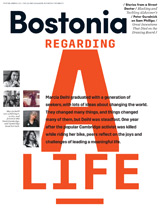
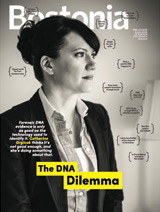



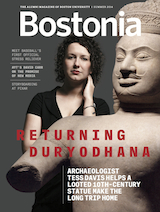








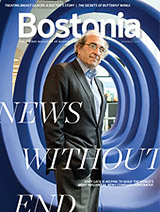






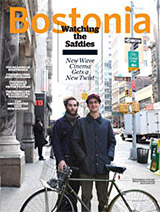





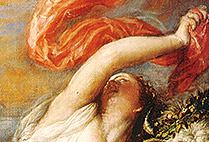



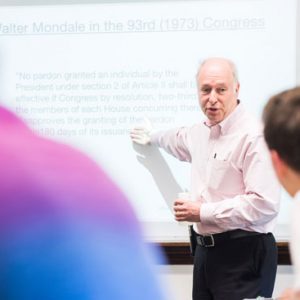





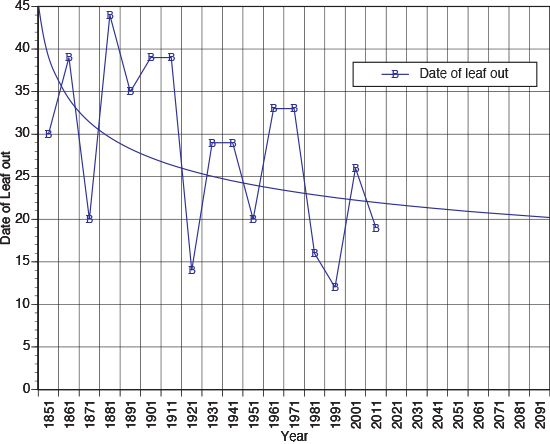

Related Stories
David Carr of the New York Times to Join COM
First Lack Professor will start teaching next fall
Former New York Times Colleagues on Media’s Future
David Carr talks with Jill Abramson
David Carr 1956–2015
COM prof and New York Times columnist dies unexpectedly
Post Your Comment